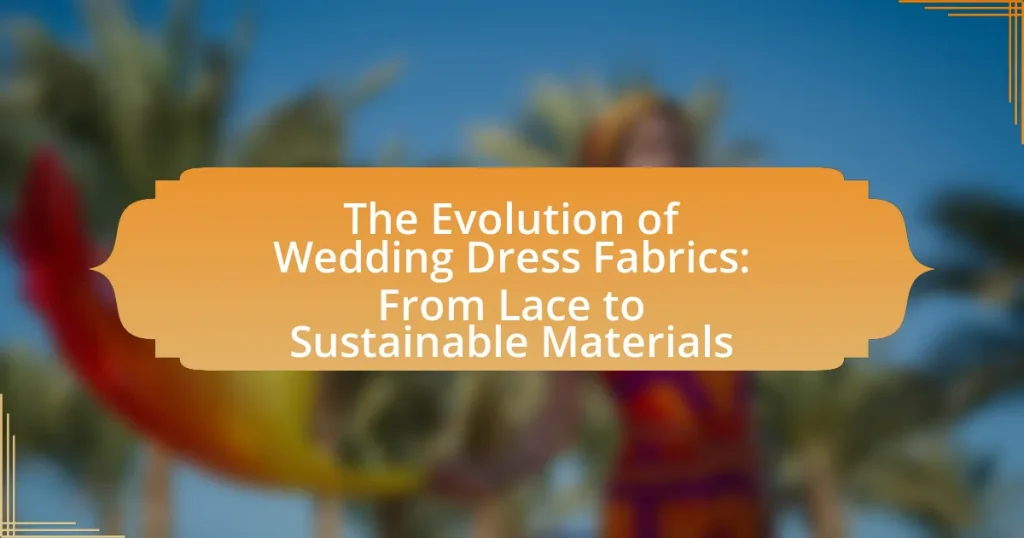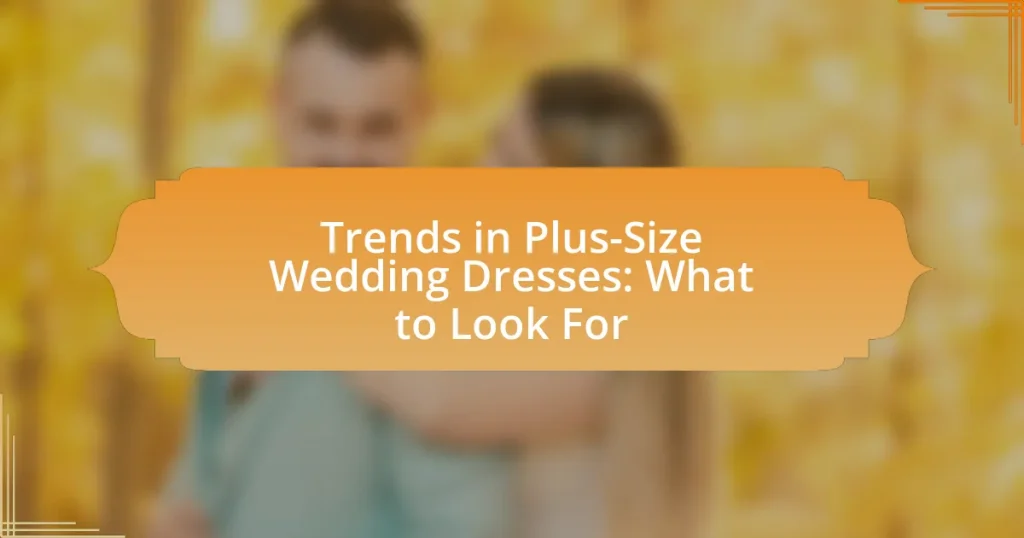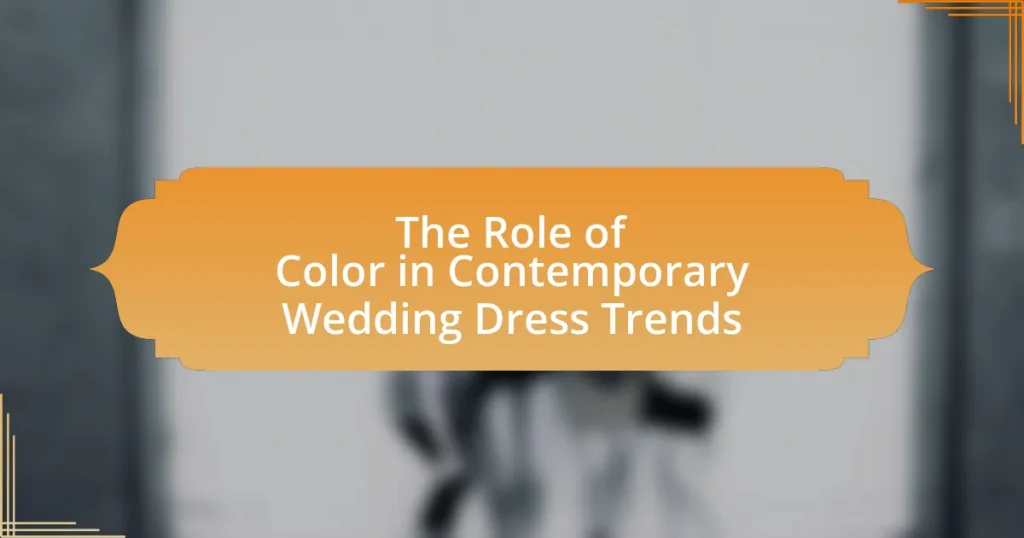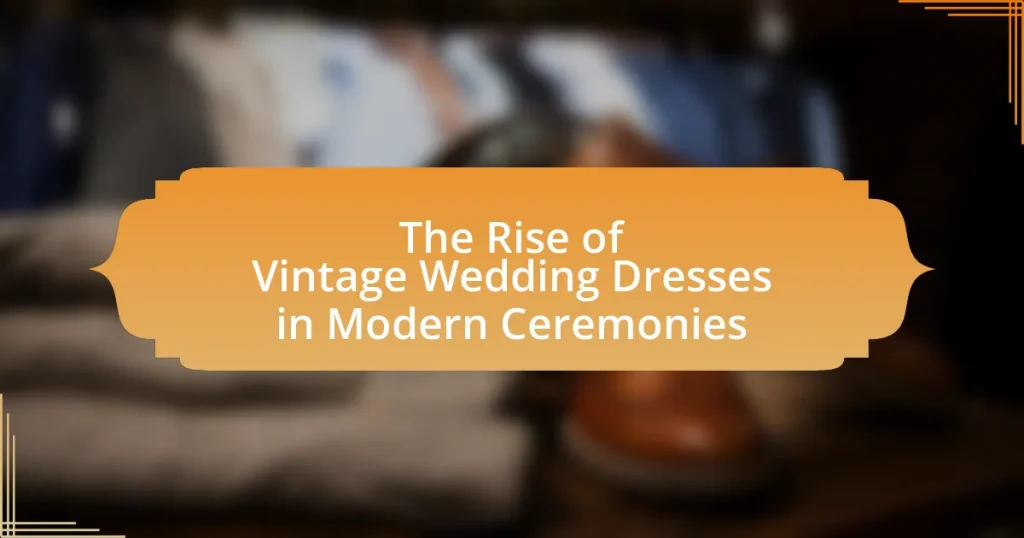The article examines the historical evolution of wedding dress fabrics, tracing their origins from ancient civilizations to modern sustainable materials. It highlights the significance of traditional fabrics such as silk, satin, and lace, detailing their cultural influences and changing perceptions over time. The discussion includes the rise of lace as a symbol of elegance, the impact of Queen Victoria on bridal fashion, and the contemporary shift towards eco-friendly fabrics like organic cotton and recycled polyester. Additionally, the article explores how advancements in technology and consumer demand for sustainability are shaping current trends in wedding dress design.
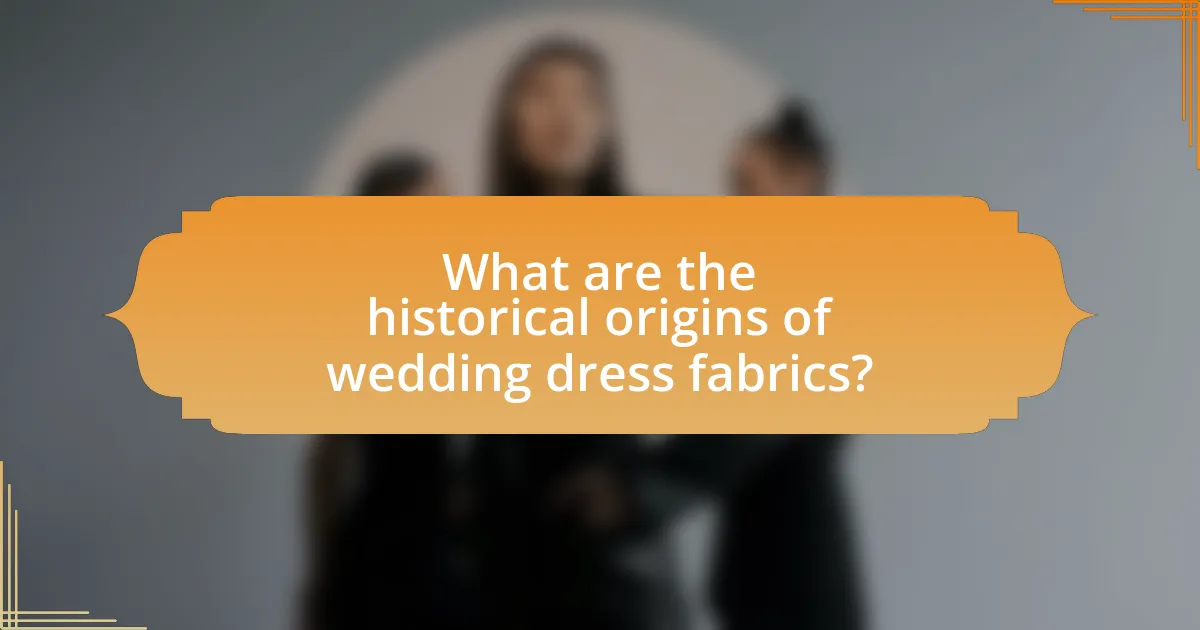
What are the historical origins of wedding dress fabrics?
The historical origins of wedding dress fabrics can be traced back to ancient civilizations, where materials like silk, linen, and wool were commonly used. In ancient Rome, brides wore tunics made of wool, symbolizing modesty and purity, while in medieval Europe, wealthy brides often chose silk and brocade, reflecting their social status. The introduction of lace in the 16th century marked a significant evolution, as it became a popular embellishment for wedding gowns, particularly among the aristocracy. By the 19th century, the white wedding dress, popularized by Queen Victoria, led to the widespread use of cotton and satin, making these fabrics synonymous with bridal wear. This historical progression illustrates how cultural influences and societal norms have shaped the choice of fabrics in wedding dresses over time.
How did lace become a popular choice for wedding dresses?
Lace became a popular choice for wedding dresses due to its intricate designs and association with elegance and femininity. Historically, lace was introduced in the 16th century and gained prominence in the 19th century, particularly during Queen Victoria’s wedding to Prince Albert in 1840, where she wore a white lace gown. This event significantly influenced bridal fashion, leading to lace being viewed as a symbol of purity and sophistication in wedding attire. The delicate craftsmanship of lace also allowed for a variety of styles, making it versatile for different bridal aesthetics, further solidifying its status in wedding dress design.
What cultural influences contributed to the use of lace in weddings?
The use of lace in weddings has been significantly influenced by European cultural traditions, particularly from France and England. In the 16th century, lace became a symbol of wealth and status among the aristocracy, with intricate designs showcasing craftsmanship. The association of lace with purity and femininity further solidified its place in bridal attire, especially during the Victorian era when Queen Victoria popularized white wedding dresses adorned with lace. This cultural significance has persisted, making lace a timeless choice for weddings across various cultures, symbolizing elegance and tradition.
How has the perception of lace changed over time?
The perception of lace has evolved from a symbol of wealth and status in the 16th century to a more versatile and accessible fabric in contemporary fashion. Historically, lace was associated with nobility and was often used in elaborate garments, reflecting social hierarchy. By the 19th century, lace became more widely available due to advancements in manufacturing techniques, leading to its incorporation into everyday clothing and wedding dresses. In modern times, lace is celebrated for its romantic and delicate qualities, often used in bridal wear, while also being embraced in sustainable fashion movements, showcasing its adaptability and enduring appeal.
What other traditional fabrics have been used in wedding dresses?
Silk, satin, taffeta, and organza are traditional fabrics commonly used in wedding dresses. Silk has been favored for its luxurious feel and natural sheen, while satin offers a smooth, glossy finish that enhances the elegance of bridal gowns. Taffeta, known for its crisp texture and ability to hold shape, has been a popular choice for structured designs. Organza, a lightweight and sheer fabric, adds a romantic touch to wedding dresses. These fabrics have historical significance, with silk being used in royal weddings for centuries, reflecting wealth and status.
What are the characteristics of silk as a wedding dress fabric?
Silk is a luxurious fabric commonly used for wedding dresses due to its smooth texture, natural sheen, and ability to drape elegantly. The smooth texture of silk provides a soft feel against the skin, enhancing comfort for the wearer. Its natural sheen gives wedding dresses a radiant appearance, making them visually striking in photographs and during ceremonies. Additionally, silk has excellent draping qualities, allowing it to flow beautifully and create flattering silhouettes. The fabric is also breathable, which contributes to comfort throughout the event. Historically, silk has been associated with wealth and status, further solidifying its popularity in bridal fashion.
How does satin compare to other fabrics in terms of wedding dress design?
Satin is often preferred for wedding dress design due to its luxurious sheen and smooth texture, which create an elegant and sophisticated appearance. Unlike fabrics such as tulle or chiffon, which are lighter and more airy, satin provides structure and drape, allowing for more defined silhouettes and intricate detailing. Additionally, satin’s weight and thickness enable it to hold shapes well, making it ideal for styles that require volume, such as ball gowns. Historical trends show that satin has been a staple in bridal fashion since the 19th century, often associated with opulence and formality, further solidifying its status as a favored choice among designers and brides alike.
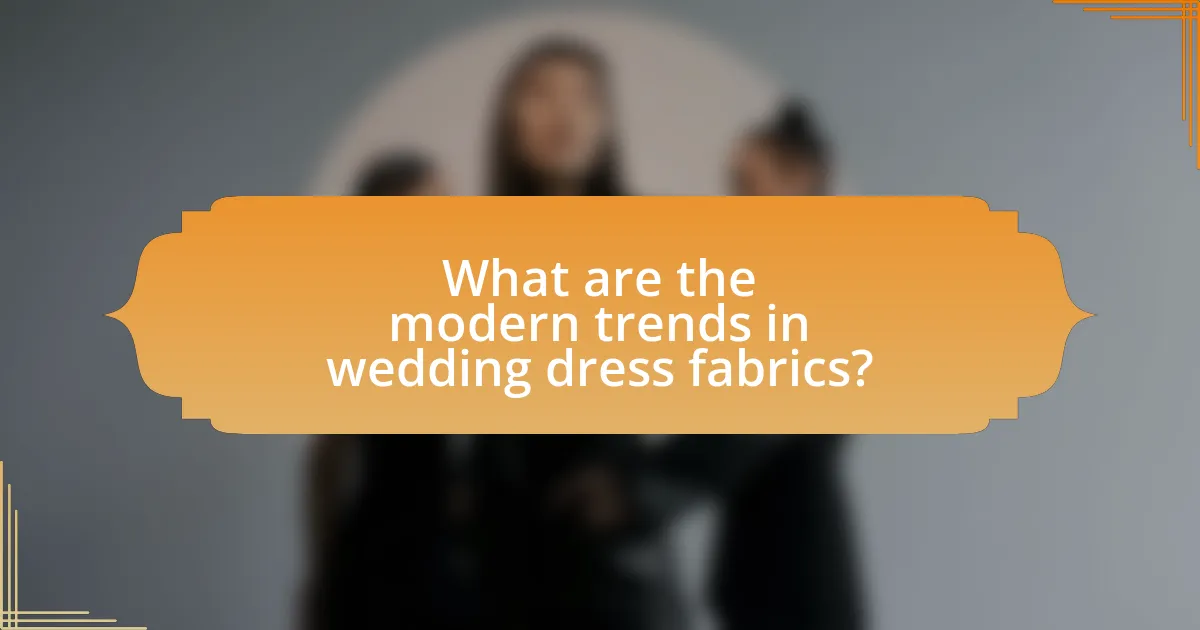
What are the modern trends in wedding dress fabrics?
Modern trends in wedding dress fabrics include the use of sustainable materials, lightweight textiles, and innovative blends. Sustainable fabrics, such as organic cotton, Tencel, and recycled polyester, are increasingly popular as couples prioritize eco-friendliness. Lightweight textiles like chiffon and tulle are favored for their comfort and flow, allowing for ease of movement. Additionally, innovative blends that combine traditional materials with modern synthetics offer unique textures and styles, catering to diverse aesthetic preferences. These trends reflect a shift towards both environmental consciousness and practicality in wedding attire.
How are contemporary designers incorporating new materials?
Contemporary designers are incorporating new materials by integrating sustainable fabrics such as organic cotton, recycled polyester, and innovative textiles like mushroom leather and bio-fabricated materials into their wedding dress collections. This shift towards sustainability is driven by a growing consumer demand for eco-friendly options, with a report from the Fashion Institute of Technology indicating that 66% of consumers consider sustainability when making fashion purchases. Additionally, designers are experimenting with advanced technologies, such as 3D printing, to create unique textures and forms, further enhancing the versatility and appeal of modern wedding attire.
What innovative fabrics are gaining popularity in the wedding industry?
Innovative fabrics gaining popularity in the wedding industry include sustainable materials such as organic cotton, Tencel, and recycled polyester. These fabrics are increasingly favored due to their eco-friendly properties and reduced environmental impact, aligning with the growing trend towards sustainability in fashion. For instance, Tencel, made from sustainably sourced wood pulp, is known for its softness and breathability, making it an attractive option for wedding dresses. Additionally, recycled polyester, derived from post-consumer plastic bottles, offers durability and a lower carbon footprint compared to traditional fabrics. This shift towards innovative and sustainable fabrics reflects a broader movement within the wedding industry to prioritize environmental consciousness while maintaining style and elegance.
How do modern wedding dress fabrics reflect current fashion trends?
Modern wedding dress fabrics reflect current fashion trends by prioritizing sustainability, versatility, and innovative textures. Designers increasingly utilize eco-friendly materials such as organic cotton, recycled polyester, and Tencel, aligning with the growing consumer demand for environmentally responsible fashion. For instance, a 2021 report by the Fashion Institute of Technology highlighted that 70% of brides are now considering sustainable options for their wedding attire, showcasing a significant shift in consumer preferences. Additionally, the use of lightweight fabrics and layering techniques mirrors contemporary trends in casual and ready-to-wear fashion, allowing for more personalized and adaptable bridal looks. This evolution in fabric choice not only meets aesthetic desires but also resonates with the values of modern consumers, emphasizing ethical production and individual expression.
What role does technology play in fabric development for wedding dresses?
Technology plays a crucial role in fabric development for wedding dresses by enabling the creation of innovative materials that enhance aesthetics, comfort, and sustainability. Advanced textile engineering techniques, such as 3D knitting and digital printing, allow designers to produce intricate patterns and textures that were previously difficult to achieve. For instance, the use of smart fabrics can provide features like temperature regulation and moisture-wicking, improving the wearer’s experience. Additionally, technology facilitates the development of eco-friendly materials, such as recycled polyester and organic cotton, aligning with the growing demand for sustainable fashion. This shift towards sustainable options is supported by research indicating that the textile industry is a significant contributor to environmental pollution, prompting a need for more responsible fabric choices.
How has digital printing changed the landscape of wedding dress fabrics?
Digital printing has revolutionized wedding dress fabrics by enabling intricate designs and vibrant colors that were previously difficult or impossible to achieve with traditional printing methods. This technology allows for customization at a lower cost and faster turnaround time, catering to the growing demand for personalized wedding attire. For instance, designers can now print high-resolution images and patterns directly onto fabrics, enhancing creativity and offering brides unique options that reflect their individual styles. Additionally, digital printing reduces fabric waste, as it allows for on-demand production, aligning with sustainable practices in the fashion industry.
What advancements in fabric technology are influencing sustainability?
Advancements in fabric technology influencing sustainability include the development of biodegradable materials, recycled fibers, and innovative manufacturing processes that reduce waste and energy consumption. Biodegradable fabrics, such as those made from organic cotton or Tencel, decompose naturally, minimizing environmental impact. Recycled fibers, like those derived from post-consumer plastic bottles, significantly reduce the need for virgin materials, thereby conserving resources. Additionally, technologies such as digital printing and 3D knitting optimize material usage and decrease water consumption, further enhancing sustainability in the textile industry. These advancements collectively contribute to a more eco-friendly approach to fabric production, aligning with the growing demand for sustainable fashion.
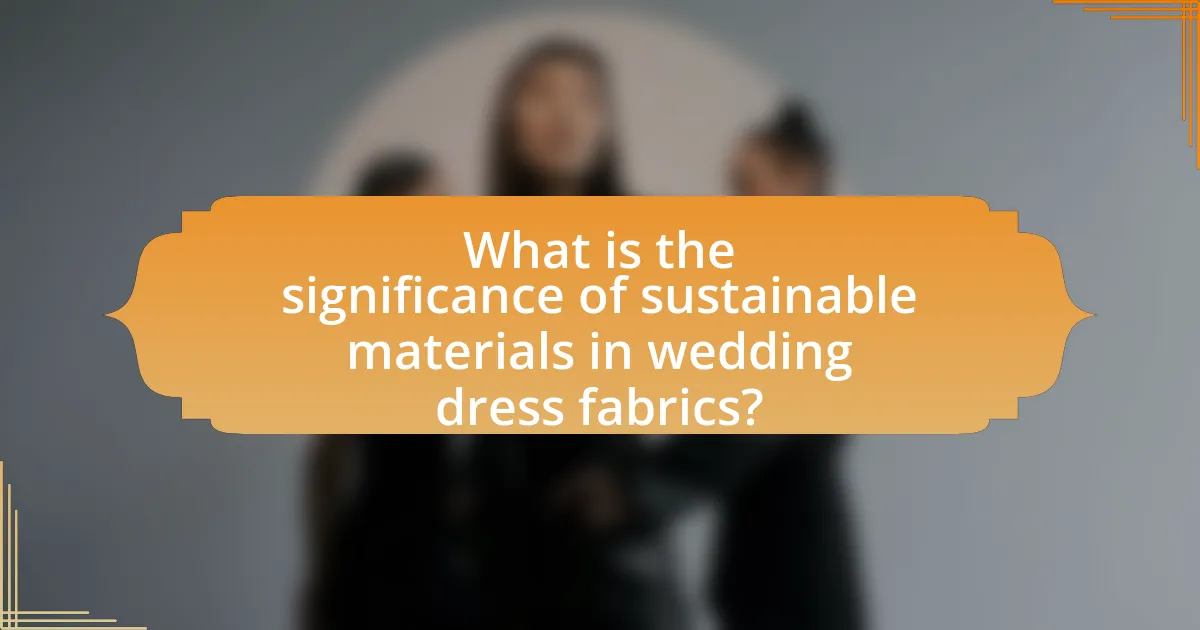
What is the significance of sustainable materials in wedding dress fabrics?
Sustainable materials in wedding dress fabrics are significant because they reduce environmental impact and promote ethical production practices. The use of organic cotton, hemp, and recycled polyester minimizes resource consumption and waste, aligning with growing consumer demand for eco-friendly options. According to a report by the Ellen MacArthur Foundation, the fashion industry contributes to 10% of global carbon emissions, highlighting the need for sustainable alternatives. By choosing sustainable fabrics, couples can make a positive statement about their values while also supporting the shift towards a more responsible fashion industry.
Why is sustainability becoming a priority in the wedding industry?
Sustainability is becoming a priority in the wedding industry due to increasing consumer awareness of environmental issues and the desire for eco-friendly practices. Couples are now more informed about the ecological impact of traditional wedding practices, leading to a demand for sustainable options such as biodegradable materials, locally sourced flowers, and ethical fashion choices. According to a survey by The Knot, 70% of couples consider sustainability when planning their weddings, indicating a significant shift towards environmentally responsible celebrations. This trend reflects a broader societal movement towards sustainability, influencing vendors and designers to adapt their offerings to meet these new consumer expectations.
What are the environmental impacts of traditional wedding dress fabrics?
Traditional wedding dress fabrics, such as silk, polyester, and lace, have significant environmental impacts primarily due to their production processes. The cultivation of silk involves raising silkworms, which requires large amounts of water and land, contributing to habitat loss and biodiversity decline. Polyester, a synthetic fabric derived from petroleum, has a high carbon footprint due to fossil fuel extraction and processing, and its production releases harmful pollutants into the environment. Additionally, lace, often made from cotton or synthetic fibers, can involve chemical treatments that further harm ecosystems. According to the Environmental Protection Agency, textile manufacturing is one of the largest sources of industrial water pollution, highlighting the detrimental effects of traditional wedding dress fabrics on the environment.
How do sustainable materials compare to conventional fabrics in terms of quality?
Sustainable materials often match or exceed the quality of conventional fabrics, particularly in durability and performance. For instance, organic cotton and Tencel are known for their breathability and softness, comparable to traditional cotton and silk. Additionally, sustainable fabrics like recycled polyester demonstrate high tensile strength and resistance to wear, similar to virgin polyester. Research indicates that sustainable materials can also be treated to enhance their properties, such as moisture-wicking and UV resistance, making them suitable for various applications, including wedding dresses.
What types of sustainable materials are available for wedding dresses?
Sustainable materials available for wedding dresses include organic cotton, hemp, Tencel, and recycled polyester. Organic cotton is grown without synthetic pesticides and fertilizers, making it environmentally friendly. Hemp is a durable and biodegradable fabric that requires minimal water and no pesticides. Tencel, made from sustainably sourced wood pulp, is produced in a closed-loop process that recycles water and solvents. Recycled polyester, derived from post-consumer plastic bottles, reduces waste and energy consumption compared to virgin polyester. These materials contribute to a more sustainable fashion industry by minimizing environmental impact.
How do organic cotton and hemp serve as alternatives to traditional fabrics?
Organic cotton and hemp serve as sustainable alternatives to traditional fabrics by offering environmentally friendly production methods and reduced ecological impact. Organic cotton is grown without synthetic pesticides or fertilizers, which minimizes soil and water pollution, while hemp requires less water and no chemical inputs, making it one of the most sustainable crops. Additionally, both materials are biodegradable, unlike many synthetic fabrics, which contribute to landfill waste. The use of organic cotton and hemp in textiles can significantly lower carbon emissions; for instance, hemp can absorb more CO2 during its growth cycle compared to cotton. This shift towards organic cotton and hemp aligns with the growing demand for eco-conscious fashion, particularly in the wedding industry, where sustainability is increasingly prioritized.
What are the benefits of using recycled materials in wedding dress design?
Using recycled materials in wedding dress design offers significant environmental benefits, including reduced waste and lower carbon emissions. By repurposing fabrics, designers minimize the demand for new resources, which conserves water and energy typically used in textile production. For instance, the fashion industry is responsible for approximately 10% of global carbon emissions; utilizing recycled materials can help mitigate this impact. Additionally, using recycled fabrics often leads to unique textures and styles, allowing for creative expression while promoting sustainability. This approach aligns with the growing consumer demand for eco-friendly practices in fashion, as studies show that 66% of consumers are willing to pay more for sustainable brands.
What practical tips can brides consider when choosing wedding dress fabrics?
Brides should consider the weight, breathability, and drape of wedding dress fabrics to ensure comfort and style. Fabrics like chiffon and organza are lightweight and breathable, making them ideal for warm weather, while heavier fabrics like satin and taffeta provide structure and elegance. Additionally, brides should assess the fabric’s texture and how it complements their body shape; for example, lace can add a romantic touch, while silk offers a luxurious feel. Understanding the care requirements of each fabric is also crucial, as some materials may require dry cleaning, while others can be hand-washed. Choosing sustainable fabrics, such as organic cotton or recycled polyester, can also align with eco-conscious values, reflecting a growing trend in the wedding industry towards environmentally friendly choices.
How can brides balance style and sustainability in their fabric choices?
Brides can balance style and sustainability in their fabric choices by selecting eco-friendly materials such as organic cotton, hemp, or Tencel, which offer both aesthetic appeal and reduced environmental impact. These fabrics are often produced with less water and fewer chemicals compared to traditional materials, making them a sustainable option. For instance, organic cotton is grown without synthetic pesticides, and Tencel is made from sustainably sourced wood pulp, both of which contribute to a lower carbon footprint. Additionally, brides can choose vintage or upcycled fabrics, which not only add unique character to their gowns but also minimize waste. This approach allows brides to achieve their desired style while supporting sustainable practices in the fashion industry.
What should brides look for in terms of comfort and wearability in fabrics?
Brides should prioritize breathable fabrics that allow for ease of movement and comfort throughout the day. Fabrics such as cotton, silk, and chiffon are known for their lightweight and breathable qualities, which help regulate body temperature and enhance comfort. Additionally, stretchable materials like jersey or spandex blends can provide flexibility, allowing brides to move freely without restriction. Research indicates that natural fibers, such as cotton and silk, are more breathable than synthetic options, making them preferable for long wear during events like weddings.
